
BIM Organizational Structures 101
- By Tarek Ghazzaoui, Eng. (senior BIM manager)
- on
Overview
Professionals are the center of the world of Building Information Modeling (BIM). It’s not tools, equipment, processes, standards or any other similar aspect; it’s people. And a good starting point for understanding BIM professionals is to understand their roles on projects, and their interrelationships to each other. These interrelationships are usually outlined and described by what is otherwise known in the world of human resources as “organizational structures”, or in simple terms, the team hierarchy.
In this article, I will discuss all about BIM organizational structures in AEC firms, including definitions, why have organization structures, types of organizational structures, professional roles, structures for small, medium and large AEC firms and some of my personal observations.
Let’s get started!
Table of contents
Note: Click to go to a specific section.
Definitions
The first thing I will discuss is: what is an organizational structure? Here is a definition according to Wikipedia (Wikipedia, 2021):
An organizational structure defines how activities such as task allocation, coordination, and supervision are directed toward the achievement of organizational aims. Organizational structure affects organizational action and provides the foundation on which standard operating procedures and routines rest. It determines which individuals get to participate in which decision-making processes, and thus to what extent their views shape the organization’s actions.
In simple terms, it is a chart that outlines the structure of the departments and team members based on their roles and responsibilities. It is usually portrayed in an organizational chart format, which is defined as follows (Wikipedia, 2021):
An organizational chart, also called organigram, organogram, or organizational breakdown structure (OBS) is a diagram that shows the structure of an organization and the relationships and relative ranks of its parts and positions/jobs. The term is also used for similar diagrams, for example ones showing the different elements of a field of knowledge or a group of languages.
The following chart is a basic example of an organizational chart of a firm’s executive team.

Why have BIM organizational structures

BIM organizational structures are very important in AEC firms because they outline the roles, responsibilities and interrelationships between different BIM professionals, in the interest of increasing productivity, efficiency, collaboration, coordination and communication, while reducing risks, issues, employee turnover and costs. AEC firms that lack an official and a clearly defined BIM organizational structure are operating in a counterproductive fashion and are deliberately blurring the expectations, roles and responsibilities of their employees.
AEC firms that lack an official and a clearly defined BIM organizational structure are operating in a counterproductive fashion and are deliberately blurring the expectations, roles and responsibilities of their employees.
Tarek Ghazzaoui, Eng.
Senior BIM Manager
The following list summarizes some of the most important reasons why AEC firms should have organizational structures for their BIM teams. In fact, these concepts apply to all teams, outside of the scope of BIM as well.
- CLEAR TITLE AND ROLE - A clear and concise title helps understand what a professional does in an organization, and what the role entails. In an organizational structure, one can clearly understand who does what, and how that fits in the overall picture of the organization.
- CLEAR RESPONSIBILITIES AND DECISIONAL POWER - Organizational structures also show to some extent the decisional power of BIM team members, which helps in knowing the professional’s capacity to make decisions, block decisions and resolve disputes. Also, although not stated explicitly in the organizational chart, the title usually has associated responsibilities, which can be retrieved from HR documents (i.e. job and role descriptions.) These vary from one organization to another, however, there are general common denominators between all AEC firms in BIM.
- CLEAR REPORTING HIERARCHY - One very important aspect of having a BIM organization structure is the clear reporting hierarchy or structure. This is especially important for escalation in case of disputes, where an issue needs to be escalated “up the ladder” to a stakeholder with greater decisional power. Also, this is important for team resourcing, billing, project management, and management, among other factors.
- CLEAR GROWN CHANNEL - An organizational structure, once defined, allows team members to see a better career path and a potential for growth. Although some BIM organizational structures are “flat” (i.e. there aren’t many positions that one can ascend to), it is important to have clarity and transparency as to what roles one can potentially obtain within a BIM team.
- HUMAN RESOURCES PARITY - Although very subtle and indirect, BIM organizational structures allow for human resources professionals to define standards across a firm and to ensure parity between similar titles, roles and responsibilities in terms of package compensation (i.e. salary, bonuses, benefits, PERKS, etc.), responsibilities, expectations, work load, among others.
This summarizes the main reasons why BIM organizational structures are important in AEC firms. Let’s discuss the types of organizational structures next.
Types of organizational structures
According to Investopedia, there are 4 types of organizational structures:
Functional
Divisional
Flatarchy
Matrix
Let’s briefly investigate each in this section.
Functional Structure
“[…] This is also referred to as a bureaucratic organizational structure and breaks up a company based on the specialization of its workforce. Most small-to-medium-sized businesses implement a functional structure. […]” (Kenton, 2021)
An example is an AEC firm that has sales, marketing, finance, operations, legal departments.
Divisional Structure
“[…] Called the divisional or multidivisional structure, a company that uses this method structures its leadership team based on the products, projects, or subsidiaries they operate.” (Kenton, 2021) Each division is its own business unit, most times with its own leadership team and a certain level of autonomy and decisional independence within the larger organization.
An example is an AEC firm that has 4 major projects, with each having its own project director, who is a shareholder in the firm.
Flatarchy Structure
The Flatarchy structure “is used among many start-ups. As the name alludes, it flattens the hierarchy and chain of command and gives its employees a lot of autonomy. Companies that use this type of structure have a high speed of implementation.” (Kenton, 2021)
This is not usually used in the AEC industry, therefore there is no good example. However, this is prevalent in the start-up world, especially those that involve technology.
Matrix Structure
“It is also the most confusing and the least used. This structure matrixes employees across different superiors, divisions, or departments. An employee working for a matrixed company, for example, may have duties in both sales and customer service.” (Kenton, 2021) The organizational chart of this type of structure can be confusing, unclear or not representative of the real role, responsibilities and position within the firm.
These organizational structures will be important to know in the following sections, as I will focus primarily on the functional and divisional structures for BIM.
BIM roles in organizational structures

In this section, let’s briefly discuss the different BIM roles in AEC firms so we have an idea what each one entails, as it will be presented in the organizational charts in the following sections.
BIM Director
A BIM director is an executive that is usually a project manager, engineer, technician or trade specialist that has 10+ years experience in BIM. This person is usually responsible for managing BIM managers, establishing and approving budgets and schedules, managing human resources (i.e. hiring, firing, resourcing, etc.), interfacing with other executives regarding the field of BIM (i.e. presenting to the president and VPs BIM-related strengths, weaknesses, opportunities and threats.)
BIM Manager
A BIM manager is usually an architect, engineer, technician or trade specialist that has 5-10 years experience in BIM. This person is usually responsible for implementing BIM solutions firmwide, establishing and providing training, support, consulting, coaching to project teams, as well as working on some projects.
BIM coordinator
A BIM coordinator is usually an architect, engineer, technician or trade specialist that has 2-5 years experience in BIM. This person is usually responsible for implementing BIM solutions firmwide, providing training, support, consulting, coaching to project teams, as well as working on projects most of the time.
BIM specialist
A BIM specialist is usually an architect, engineer, technician, trade specialist, or technology professional (DT or IT) that has any number of years of experience in BIM or in programming and development. This person is usually specialized in a field, such as computational design, automation, machine learning, realities (VR, AR, MR), data visualization, sustainability, energy efficiency, specialized engineering systems, constructability analysis, etc.
Now that we have a basic understanding of the BIM roles, let’s see how they fit within AEC firms’ organizational structures. In the next sections, the definition of what consists of a small, medium or large AEC firm is subjective; however, the criterion for defining the firm size depends on either the number of employees or the gross revenue of the firm. I will rely on the number of employees to define a small, medium and large firm in the following sections.
Organizational structures of small AEC firms (<50 employees)
The following organizational charts outline organizational structures of small AEC firms. It is worthy to note that organizational structures may differ in real life due to a multitude of factors.
Functional Structure #1
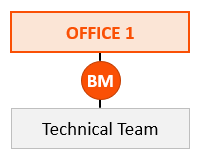
- LEGEND
- BM: BIM manager
In this structure, I’m assuming there is one office.
In this office, there’s one BIM manager, who acts like a CAD manager, and is the only BIM resource for the technical team (design, construction or operation.) This person is a “one-man-show” for the firm in terms of BIM, and is usually very involved operationally on projects.
Functional Structure #2
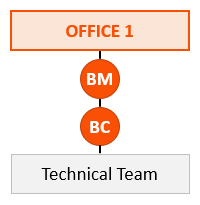
- LEGEND
- BM: BIM manager
- BC: BIM coordinator
In this structure, I’m assuming there is one office as well.
The structure is similar to the Functional Structure #1 above, but it has a BIM coordinator working with the BIM manager. The BIM coordinator helps a lot of hands-on type of work, and it allows the BIM manager to focus on the “greater picture”, which consists of topics such as the BIM execution plan, developing and optimizing content assets, plugins, scripts, providing training, etc.
In all cases, the structures may be a little bit different, and in case there are more offices, the same structure can be replicated to other offices.
Organizational structures of medium AEC firms (50-500 employees)
The following organizational charts outline organizational structures of medium AEC firms. It is worthy to note that organizational structures may differ in real life due to a multitude of factors.
Divisional Structure #1
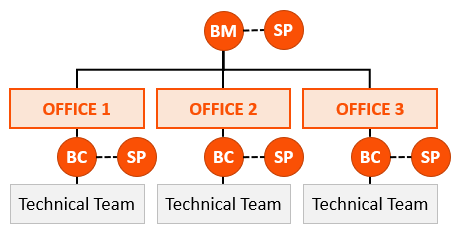
- LEGEND
- BM: BIM manager
- BC: BIM coordinator
- SP: BIM specialist
In this structure, I’m assuming there are multiple offices.
There is a BIM manager that operates at a firm level and gets involved with all offices. The BIM manager may have one or more specialists that assist with the development of content assets, documents, plugins, scripts and tools for the entire firm.
In each office, there is BIM coordinator that assists the technical team with hands-on help and reports to the BIM manager. The BIM coordinator may have one or more specialists that assist with the development of content assets, documents, plugins, scripts and tools for that particular office.
Divisional Structure #2
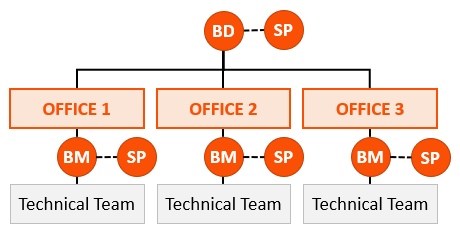
- LEGEND
- BD: BIM director
- BM: BIM manager
- BC: BIM coordinator
- SP: BIM specialist
In this structure, I’m assuming there are multiple offices.
This structure is similar to Divisional Structure #1, except that there is BIM director at the helm of the firm, and each office has a BIM manager instead of a BIM coordinator. In this case, the BIM director is usually an executive and interfaces with other executives on top of all his BIM-related responsibilities.
Divisional Structure #3
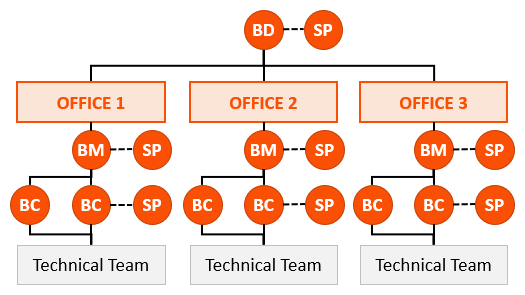
- LEGEND
- BD: BIM director
- BM: BIM manager
- BC: BIM coordinator
- SP: BIM specialist
In this structure, I’m assuming there are multiple offices.
This structure is similar to Divisional Structure #2, except that there is one or more BIM coordinators in each office that assist the BIM manager. So the BIM coordinators report to the BIM managers in each office, and the BIM managers in each office report to the firmwide BIM director.
At any level, there may be BIM specialists that can assist the BIM director, BIM managers or BIM coordinator with the development of tools, scripts, software, dashboards, plugins, etc.
In all cases, the structures may be a little bit different, and in case there are more offices, the same structure can be replicated to other offices.
Organizational structures of medium AEC firms (50-500 employees)
Multi-Divisional Structure
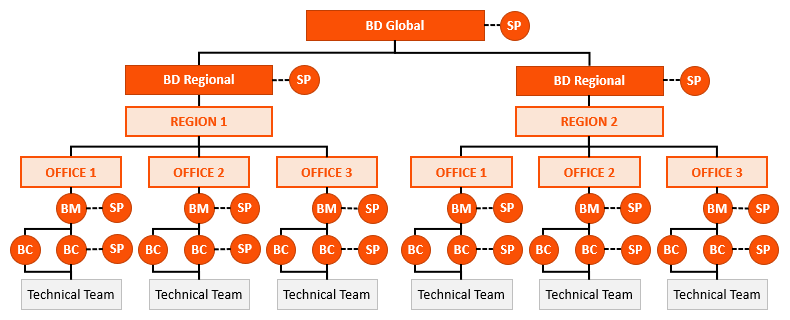
- LEGEND
- BD: BIM director
- BM: BIM manager
- BC: BIM coordinator
- SP: BIM specialist
In this structure, a large AEC firm with multi-divisional structure must have multiple offices.
There is a BIM director for global operations, that is responsible for all regions of a firm. That person is responsible for overall development, implementation and adoption of BIM in the firm, and has dedicated budgets for internal or cross-regional initiatives. The BIM Director Global has the most macro view of BIM in the firm, which offers a key position to leverage all regions’ efforts and developments and tie them together in one unified firm.
In each region, there is a regional BIM director that reports to the BIM Director Global, and may have BIM specialists that assist with the development of tools, scripts, plugins, etc. for the entire region. The BIM Director Regional usually has a great level of independence and autonomy, with dedicated budgets, schedules, equipment and teams for the region. In each region, there are offices.
IMPORTANT NOTE - A “region” is defined as a geographic area where a firm’s offices are located that share common standards and markets. Regions are usually delimited by continents (i.e. Africa), subcontinents (i.e. North America), countries (i.e. France), or regions within countries (i.e. Canada East Coast).
In each office, there is a BIM manager and one or more BIM coordinators. The roles are the same as other structures discussed earlier. BIM specialists may assist at all levels, including the BIM Director Global, BIM Directors Regional, BIM Managers (office) and BIM coordinators (office).
In all cases, the structures may be a little bit different, and in case there are more offices, the same structure can be replicated to other offices.
Personal observations

Having worked as a consultant for the better part of my career in BIM from 2010 to today, I can share the following personal observations about BIM organizational structures:
Observation #1: AEC firms do not always hire the right people
This cannot be emphasized enough, as I came across many firms that have unqualified or poorly qualified professionals in BIM roles in the AEC industry. If a professional is sufficiently qualified to work but not an ideal candidate, AEC firms should provide the tools, equipment, support, financial backing and corporate backing to bring them up to level. It is their responsibility since they will be the primary beneficiaries of the benefits. I couldn’t agree more with Dee Hock’s following statement:
An organization, no matter how well designed, is only as good as the people who live and work in it.
Dee Hock
Founder and former CEO of the Visa credit card association
Source: BrainyQuote, 2021
Observation #2: AEC firms sometimes paint with a broad brush
One cannot take a generic structure or solution and implement it across the globe, regions, offices or within offices. It really takes human interpretation and management experience to judge what is right and what is wrong for the situation at hand, and to time the changes accordingly so as not to rock the boat in a way that may cause t to capsize or tip violently.
In tangible terms, wrong, sudden or massive changes can cause a mass exodus from the company, or a sustained employee attrition over a period of time. Some AEC firms do paint with a broad brush, and I have worked for companies before that were a victim of this misjudgment.
Observation #3: AEC firms are not always transparent
This is a little touchy, but the general observation is that AEC firms are not transparent about hierarchies. Some firms refuse to share an organizational chart outright, while others have a rigorous chart that they rely on for the simplest requests. In either case, I strongly believe that AEC firms should not in extremes in this regard; in other words, do not oppose having a BIM organizational chart or have it set in stone if one is created.
Observation #4: AEC firms do not manage change properly or correctly
I could go on for weeks about change management in the AEC field, but I observed on many past occasions that AEC firms do not manage change properly or correctly. Change, in this context, refers to business expansion and technological evolution.
In the business expansion case, this means that there is no serious consideration of a growth strategy and how to manage this expansion in BIM. AEC firms deal with change as it comes, and they don’t proactively plan this out. In the technological evolution case, this means that there is no proper future planning for what is coming up in terms of new technologies, tools, equipment, etc. related to BIM. AEC firms manage change primarily because it is required or mandated on projects by clients.
In both cases, I believe that most AEC firms do not manage this correctly or properly because they are not proficient at change management.
I’ll limit my personal observations to those mentioned above, although I have many more observations about this topic. Since BIM organizational hierarchies combine multiple topics, including BIM, human resources, management and operations, it can be a big can of worms to discuss at length.
Final thoughts
The topic of BIM organizational structures is very interesting to me, and I strongly believe it is an underrated topic in AEC firms. As mentioned in my personal observations, some firms refuse to have one, and others abide by it for everything. It is best to work in moderation and to utilize a BIM organizational chart for what it was intended for, which is to outline roles, responsibilities, reporting structure, decisional power and interrelationships between roles, departments, divisions, offices, regions and project teams.
BIM organizational structures are nice and important, but what’s nicer and more important is how they are implemented and used in real life. Titles on complicated organigrams mean nothing if they are not useful in real life, and it is important to ensure that BIM professionals posses the respective authority, decisional power and mandate to successfully complete their work.
I would like to end on this quote by Harold Geneed, who states this very message ever so eloquently.
Every company has two organizational structures: the formal one is written on the charts; the other is the everyday relationship of the men and women in the organization.
Harold S. Geneen
American businessman
Source: Quotesmaster, 2021
Thank you for taking the time to read my blog article and I’ll see you again soon.

Tarek Ghazzaoui, Eng.
Senior BIM Manager
Share now!
Resources
None.
Works cited
“Organizational Structure.” Wikipedia, Wikimedia Foundation, 7 Nov. 2021, en.wikipedia.org/wiki/Organizational_structure
“Organizational Chart.” Wikipedia, Wikimedia Foundation, 3 Oct. 2021, en.wikipedia.org/wiki/Organizational_chart
Kenton, Will. “How Organizational Structures Work.” Investopedia, Investopedia, 7 Dec. 2021, www.investopedia.com/terms/o/organizational-structure.asp
“Quotes about Organization Charts.” Quotemaster. Quotes about Organization Charts (20 Quotes), accessed 13 Dec. 2021, www.quotemaster.org/organization+charts.
“Organization Quotes.” BrainyQuote, Xplore, accessed 13 Dec. 2021, www.brainyquote.com/topics/organization-quotes
About the author

Tarek Ghazzaoui, Eng. (senior BIM manager)
- articles by Tarek, bim, bim corporate structure, bim hierarchy, bim organigram, bim organizational chart, bim organizational structures, bim structure, bim team hierarchy, corporate structure, featured, obs, organizational breakdown structure, organizational chart, organizational charts, organizational structure, organizational structures, organogram

